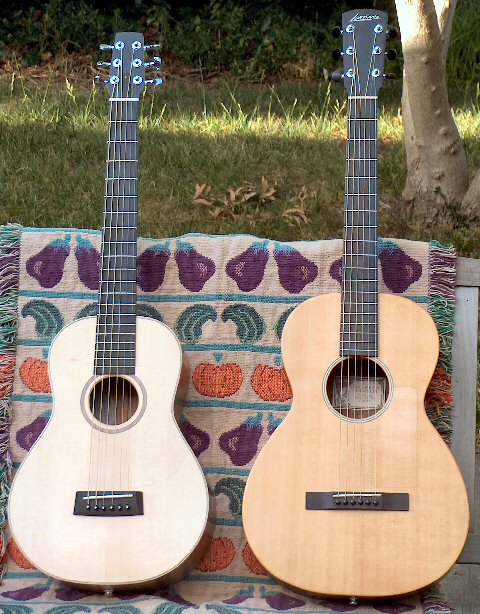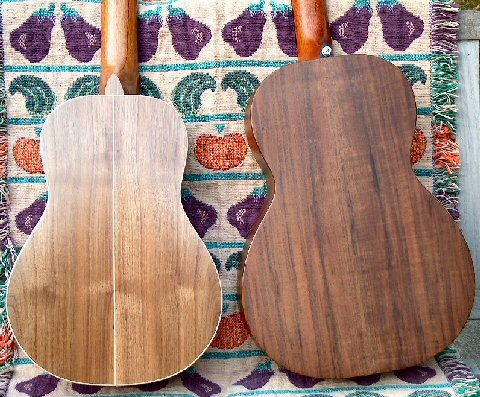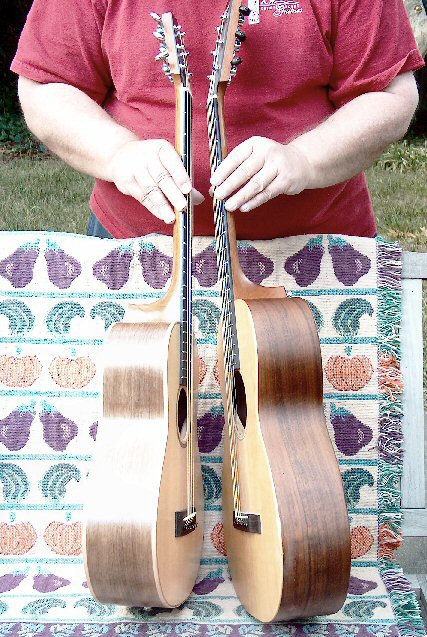Go Type II Parlor travel guitar
Just before we left for Hawai`i in April, I received my handmade Go Type II Parlor guitar from Sam Radding at Go Guitars. You can see some clips of this little instrument in action at my Kaleponi Music News blog.
For the last few years, I’ve checked my full size guitar in a Calton case, but I really enjoy having a guitar with me during those long airport waits. When I learned that Mr. Radding would build one of his parlor guitars with a custom neck shape and bridge spacing, I signed up. His guitar turned out to be a great success, small enough to fit in the airliner overhead compartment, good enough to play on stage at the Royal Hawaiian Hotel.
When we returned from our trip, I contacted Matt Hayden to see if we could get together to compare his Larrivee Parlor to this new one. Matt’s guitar is walnut and sitka, just like the Go, so the comparison seemed like a natural.
Here are some pics showing the two guitars side by side.

The Larrivee is several years older, so the sitka spruce top has mellowed to a lovely shade. The smaller body of the Go is evident in this shot, as is the compact headstock and lesser overall length.

Looking at a closeup of the backs, I prefer the walnut back of the Larrivee with its slight curly figure and darker finish, but many people commented favorably on the interesting figure of the Go walnut. The bookmatch on the Go two piece back is nicely done, and the backstrip adds a little appeal as well.

This side by side shot illustrates the shorter body and longer scale of the Go. I think it’s amazing that Mr. Radding has squeezed so much guitar into such a diminuitive shape.
I plugged a DPA 4061 mic into my Marantz PMD670 recorder and played a verse of “Kui Lima” on each guitar. Here’s the Larrivee sample (link). The Go sounds like this (link). In person, the Go seemed a little fuller and a bit louder. In fact, everyone who tried the Go so far has expressed amazement at the amount of sound that pours out of this tiny guitar.
As far as playability, the comparison is a bit unfair. I owned a Larrivee similar to Matt’s but sold it because I had a hard time with neck shape and bridge spacing. One of the great advantages of the Go Parlor is the availability of custom neck shape and bridge spacing. The slightly wider neck and bridge on my Go Parlor makes all the difference in ease of playing.
The first generation of Larrivee Parlors, like Matt’s, were built as style 01 Larrivees, which means they were stripped down models. They were also a wonderful bargain. But these days Larrivee only builds these guitars with style 09 trim. They’re much more nicely finished but cost over twice the price of the older model. The Go, which is handmade and available with custom features, is a terrific value and a very fine way to carry your music with you wherever you go.
This entry was posted on Tuesday, June 12th, 2007 at 9:29 pm and is filed under Comparisons, Guitar. You can follow any responses to this entry through the RSS 2.0 feed. You can leave a response, or trackback from your own site.
steve miller said in post # 1,
on April 16th, 2009 at 8:44 am
Hi Fran,
Thanks for posting your impressions of your Go Parlor…
I’m in the process of purchasing one from Sam Radding…
Curious what sort of neck profile/nut spacing you have on yours?
Seems to be little chunkier vs. the Larrivee… which is what I was looking for.
Beautiful guitar btw.
Thanks,
Steve
Fran Guidry said in post # 2,
on April 16th, 2009 at 10:10 am
The chunky neck (and bridge spacing) was the reason I went to Sam. Mine is 1 13/16 at the nut and 2 5/16 at the bridge, with a fairly beefy neck. My hand cramps if the neck has too little front to back depth.
Thanks for stopping by,
Fran
Jan Campbell said in post # 3,
on July 25th, 2010 at 9:10 am
I have to say that I think I have finally found the guitar I have been searching for. The Go Guitar Type II is it!
After listening to your soundbites I’m sure. Thanks for you review. JC
Ben said in post # 4,
on March 7th, 2011 at 2:29 pm
Fantastic review. Very useful comparison. Thank you.
Matt said in post # 5,
on September 12th, 2014 at 1:22 pm
I’m fond of the Larrivee – it’s been a good guitar. It doesn’t record particularly well, but it amplifies wonderfully and actually sounds pretty good in person.